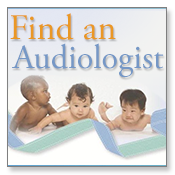About Genetics and Hearing Loss
‹View Table of Contents
What Are Genes?
Genes are the basic blocks of information that all of the body’s cells use to do what they are supposed to do. For example, genes tell heart cells how to beat, stomach cells how to digest food, and muscle cells how to move. Genes also contain the information for normal growth and development, and they help determine each person’s physical features, such as height, eye color, and hair color.
Genes are made up of a chemical called deoxyribonucleic acid (DNA). DNA is made up of two chemical chains joined together like rungs on a ladder. At each rung along the DNA chain there is a part of DNA called a base. Four different bases make up DNA, and they are called A, C, T and G, for short. The specific order, or sequence, of all the As, Cs, Ts, and Gs in DNA determines the exact information carried in each gene, like the way that a specific pattern of letters makes up the words in a sentence. Please see Figure 2 for the relationship between bases, genes, DNA, chromosomes, and cells.
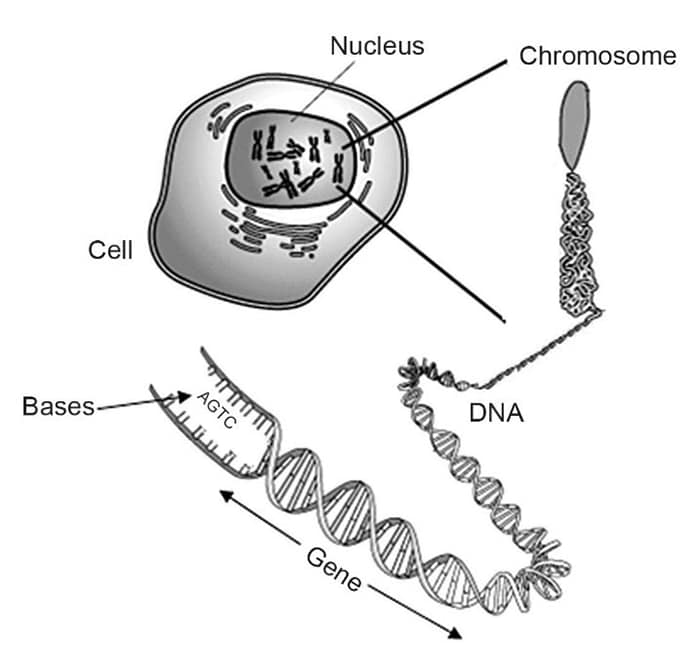
What Happens When Genes Change?
When DNA bases are missing, changed, or out of order, instructions for gene are changed so that they can’t provide the information that cells need. These changes can cause various conditions, depending upon the types of changes and the genes involved. Some DNA changes can cause hearing loss with other conditions (syndromic) and/or hearing loss by itself (nonsyndromic). Even among families with hearing loss in multiple relatives, DNA changes are not always found. Scientists are working to find all of the DNA-related causes for hearing loss.
Here is an example of a gene change. Suppose part of a gene usually has the sequence GTAC. However, in some people, the sequence has changed to GTTC. This change can alter the way that the gene works so that people with this DNA change will have a particular condition. Keep in mind that not all DNA changes result in a noticeable change in the person.
How Are Genes Passed to Children?
About half of a child’s DNA comes from each parent through the egg from the mother and the sperm from the father. Thus, a child will have features similar to each parent.
Within each cell of a person’s body, the genetic instructions (DNA) are packaged into larger units called chromosomes. Each person typically has 23 pairs of chromosomes. One chromosome of each pair is from the person’s mother and the other chromosome of each pair is from the father.
Usually, human cells have 46 chromosomes that occur in 23 pairs. The first 22 pairs of chromosomes, called number 1 to 22, are the same in males and females. The 23rd pair is called the sex chromosomes. They help determine if a person is born male or female. A female has two X chromosomes, and a male has one X and one Y chromosome. A mother will give one of her two X chromosomes to each of her children. A father will give either his X or his Y chromosome. A child who gets the father’s Y chromosome will be male. A child who gets the father’s X chromosome will be female.
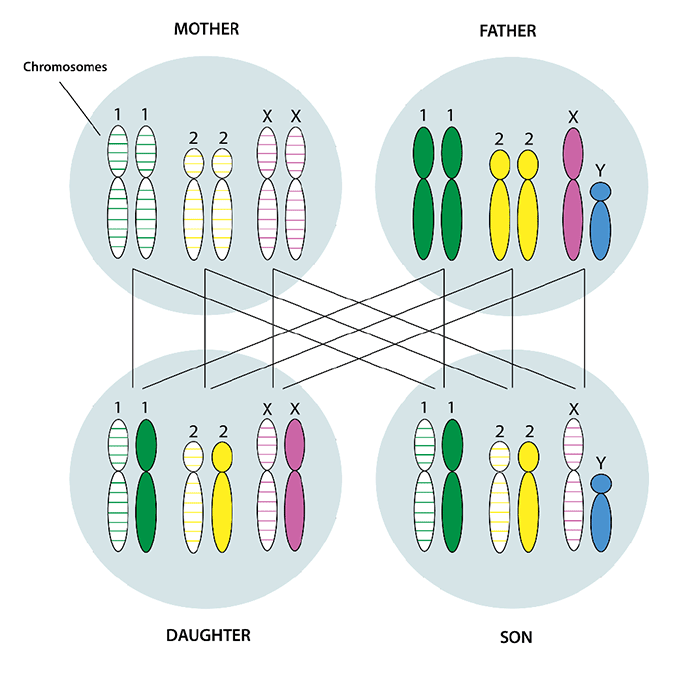
Figure 3 shows how children get their chromosomes and, therefore, their genes and DNA from their parents. In this figure, three of the 23 pairs of chromosomes are shown: pair #1 (green), pair #2 (yellow), and the sex chromosomes (purple and blue). The father’s chromosomes are shown in solid color, and the mother’s are striped. A child randomly gets one of each pair of chromosomes from the child’s mother (striped) and one of each pair from the father (solid). Each daughter gets an X from her mother (striped) and an X from her father (solid). Each son gets an X from his mother (striped) and a Y from his father (solid).
What Are the Different Ways Genes Can Cause Conditions in Children?
Genetic conditions can be described by the chromosome that contains the gene or DNA change. If the gene is part of one of the first 22 pairs of chromosomes, called autosomes, the genetic condition is called an “autosomal” condition. If the gene or DNA change is part of the X chromosome, the condition is called “X-linked” or “sex-linked.”
Genetic conditions can be further grouped based on who they affect in families. Changes in and around genes cause conditions to occur within members of the same family in certain patterns, called autosomal “dominant,” autosomal “recessive,” and X-linked “recessive.”
Autosomal Dominant Conditions
“Autosomal” conditions affect both males and females equally. In “dominant” conditions, the condition is passed from parent to child. Even when only one parent has a dominant condition, the condition can still be passed on to their children. When one parent has a dominant condition, each child has a 50% (1 in 2) chance of having it as well. All members of the family with one gene with the dominant change will have the condition because it takes only one gene with a dominant change to cause the condition.
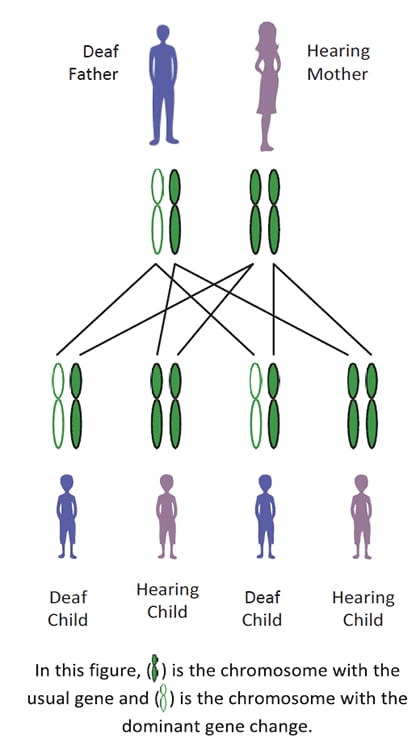
Figure 4 shows how children acquire dominant conditions from their parents. In this example shown, the chromosome with the usual gene is symbolized by (![]() ) and the chromosome with the dominant gene change is symbolized by (
) and the chromosome with the dominant gene change is symbolized by (![]() ). When one parent has the dominant condition, he or she has the usual gene (
). When one parent has the dominant condition, he or she has the usual gene (![]() ) and a gene with the dominant gene change (
) and a gene with the dominant gene change (![]() ). He or she will pass on to each child one or the other. Therefore, each child has a 50% (1 in 2) chance of getting the gene with the dominant gene change and having the condition.
). He or she will pass on to each child one or the other. Therefore, each child has a 50% (1 in 2) chance of getting the gene with the dominant gene change and having the condition.
If the other parent has two chromosomes with the usual genes, and therefore does not have the condition, he or she will pass on to each child one of the two usual genes (![]() ). Even though a child gets one of the usual genes from the parent who does not have the condition, if he or she gets a dominant changed gene from the parent with the condition, the child also will have the condition.
). Even though a child gets one of the usual genes from the parent who does not have the condition, if he or she gets a dominant changed gene from the parent with the condition, the child also will have the condition.
Most of the time, children with autosomal dominant hearing loss will have a parent with the same dominant gene change and hearing loss. However, the child may be the first one diagnosed in the family. The parent and child may not show the same symptoms or level of hearing loss, or the symptoms may not appear at the same time.
If a child has an autosomal dominant type of hearing loss, but the parents are hearing, the child may be the first in the family to have the changed gene (sporadic). When this child grows up and has children, each of the children has a 1 in 2 chance of getting the changed gene.
Autosomal Recessive Conditions
“Autosomal” conditions affect males and females equally. “Recessive” conditions are due to changes in or around genes, but they appear in families in a different way than dominant conditions. This is because people who have one recessive gene change do not have the condition. They are called “carriers.” If two carriers have a child together, there is a 25% (1 in 4) chance that the child will get two recessive changed genes, one from each parent. This child will have the recessive condition. Only children who have no usual genes will have the recessive condition.
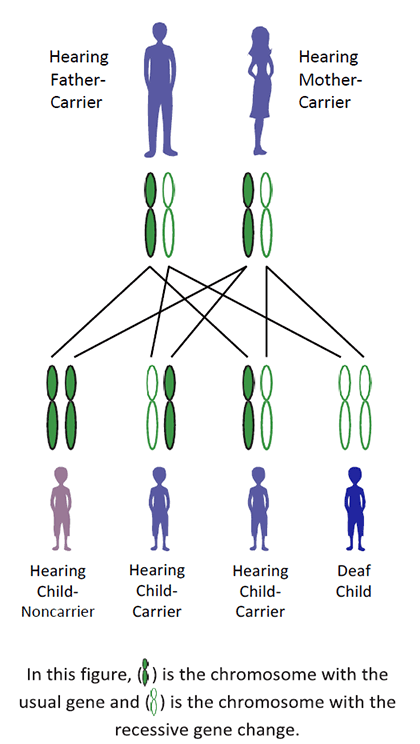
Figure 5 shows how recessive conditions appear in families. In this example, each parent is a carrier and has a chromosome with one usual gene (![]() ) and one chromosome with a recessive gene change (
) and one chromosome with a recessive gene change (![]() ). Each parent will pass on to a child either the usual gene (
). Each parent will pass on to a child either the usual gene (![]() ) or the gene with the recessive change (
) or the gene with the recessive change (![]() ). Each has a 50% (1 in 2) chance of happening. If the child gets one usual gene (
). Each has a 50% (1 in 2) chance of happening. If the child gets one usual gene (![]() ) from one parent and one gene with the recessive change (
) from one parent and one gene with the recessive change (![]() ) from the other parent, the child will be a carrier, just like both parents. If the child gets a gene with the recessive change (
) from the other parent, the child will be a carrier, just like both parents. If the child gets a gene with the recessive change (![]() ) from both parents, and therefore doesn’t have the usual gene, the child will have the condition. When both parents are carriers, there is a 25% (1 in 4) chance that each child will get a gene with a recessive change from both parents and, therefore, have the condition.
) from both parents, and therefore doesn’t have the usual gene, the child will have the condition. When both parents are carriers, there is a 25% (1 in 4) chance that each child will get a gene with a recessive change from both parents and, therefore, have the condition.
Two people with the same recessive condition caused by the same gene change will not necessarily have the same level of hearing loss nor will the hearing loss appear at the same age. Predicting the exact outcome of the changed genes in another person (or sibling) may not be straightforward.
X-Linked Recessive Conditions
Hearing loss can also occur as an X-linked condition. These conditions usually affect only males. In such instances, a change in or around a gene is passed in the family through female carriers who do not have the condition. However, each son of a female carrier has a 50% chance of getting the changed gene and, therefore, of having the condition.
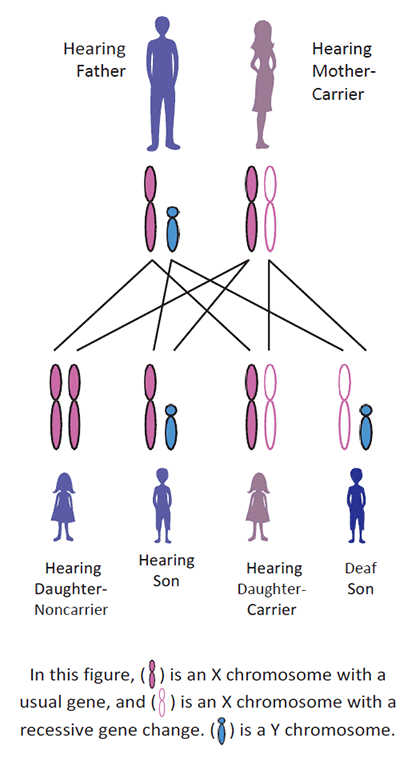
Figure 6 shows an example of inheritance of an X-linked recessive condition. “X-linked” genes are genes that are part of the X chromosome. “Recessive” means that a person who does not have at least one usual gene will have the condition.
A female has two X chromosomes and, therefore, two of each X-linked gene. A woman who has one usual gene and one gene with a recessive change is called a carrier. A carrier does not have the condition but can pass the gene with the recessive change on to her children.
A male has only one X chromosome, which was passed down from his mother. His other sex chromosome is a Y chromosome that he received from his father. Therefore, a male has only one of every gene on the X chromosome. If the male gets his mother’s X chromosome that has the recessive gene change, he will have the condition. If he gets his mother’s X chromosome that has the usual gene, he will not have the condition. Therefore, a son of a carrier mother has a 50% chance of having the condition. A daughter of a carrier mother will similarly have a 50% chance of getting the X chromosome with the recessive gene change from her mother, but if her father has an X chromosome with the usual gene, the daughter will not have the condition, but will be a carrier, like her mother. A daughter of a carrier mother also has a 50% chance of getting the X chromosome with the usual gene from her mother, and if the daughter also gets an X chromosome with the usual gene from her father, she won’t be a carrier but instead will be a non-carrier.
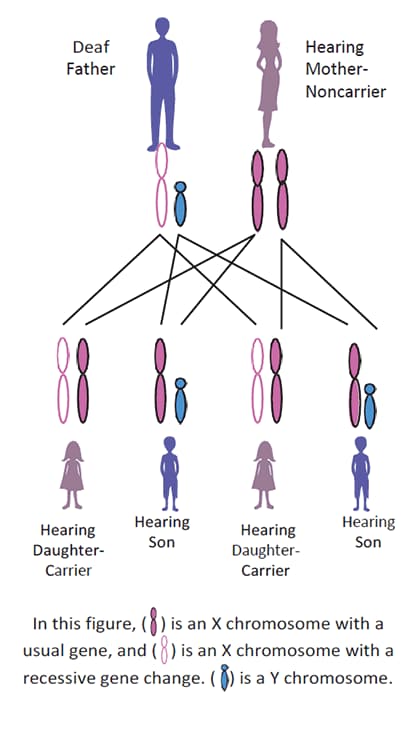
Figure 7 shows X-linked inheritance from a father with the condition. A male has only one X chromosome, and if he passes the X chromosome to his child, the child will be female. If the X chromosome he passes has the recessive gene change, each daughter will be a carrier. A male has only one Y chromosome, and if the father passes the Y chromosome to his child, the child will be male. None of his sons will have the condition or be carriers, as long as the mother did not pass an X chromosome with the recessive gene.
When a male child has hearing loss caused by a changed gene that is part his X chromosome, but neither of his mother’s X chromosomes have the changed gene, she is not a carrier. In this case, the child may be the first in the family to have the changed gene (sporadic). If this child has children, then all of his daughters will get the changed gene and be carriers, and all of his sons will not get the changed gene, so they will not have the condition.
The GJB2 gene contains the instructions for a protein called Connexin 26. This protein is needed for a part of the ear called the cochlea to do its job. The cochlea is a very complex and specialized part of the body. It needs many instructions to form and work correctly. These instructions come from many genes, including GJB2, GJB3, and GJB6. Changes in any one of these genes can result in hearing loss. However, unlike other autosomal recessive causes for hearing loss where severity or progression may not be predictable, GJB2-related hearing loss can be predicted based on the specific gene change. Read more detailed information about changes in the GJB2 gene and hearing loss.
Among some populations, about 50% of children with a genetic hearing loss who do not have a syndrome will have a DNA change in the GJB2 gene. There are many different gene changes that can cause hearing loss. Most of these changes are recessive, meaning that a person can have one usual copy of the gene and one copy of the changed GJB2 gene and will have full hearing function. (Everyone has two GJB2 genes, one from each parent.) However, a person who has two changed GJB2 genes, one from each parent, will have hearing loss. This means that if both parents have just one changed GJB2 gene, they can have a child with hearing loss, even though both parents can hear. In fact, most babies with hearing loss are born to parents who can hear.
Multifactorial Conditions
Some conditions, such as hearing loss, can be caused by a combination of genetic and non-genetic factors. These conditions are said to be “multifactorial.” People who have multifactorial conditions often are born into families with no other affected members. Parents of a child with any such condition have a greater chance of having another child with the same condition than parents who do not have a child with the condition.
If a couple without hearing loss has a child with hearing loss, there are no other relatives with hearing loss, and a specific cause of the hearing loss has not been sought, the couple’s chance of having another child with hearing loss is about 18%. However, if the child has been tested for the known genetic and non-genetic causes of hearing loss and none are identified, then the child is considered to have multifactorial hearing loss. In this case, the couple’s chance of having another child with hearing loss is 3-5%.
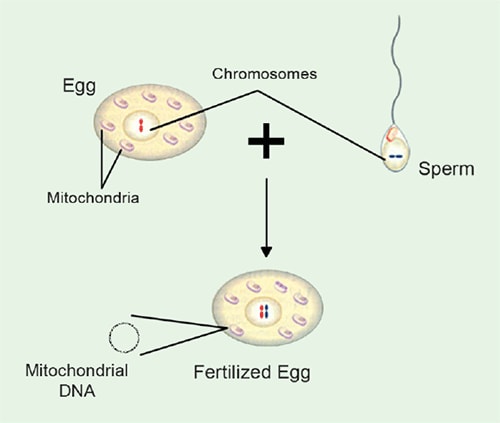
Mitochondrial Conditions
“Mitochondrial” conditions are different from most other genetic conditions because only the mother can pass them to her children. Also, the child receives a mixture of mitochondria that have a proportion of mitochondria with and without the changed genes. The amount of each type can be very different, ranging from all mitochondria with no gene change or all with the changed genes to a combination of everything in between. If a woman has a mitochondrial condition, the chance that she will pass it on to her children depends on the particular condition and on the amount of changed mitochondrial genes that the child receives. Fathers with a mitochondrial condition do not pass it on to their children.
There are genes that exist outside of chromosomes within a person’s cells. A few genes are found on small, circular pieces of DNA in the mitochondria called the mitochondrial chromosome. Mitochondria are tiny parts of cells that make energy, and the mitochondrial genes are particularly important for cells with high energy needs, particularly in the brain, nerves, eyes, ears, heart, and muscles. Each cell has many mitochondria, and every mitochondrion has many copies of the mitochondrial chromosome. The chance that a person will have a mitochondrial condition depends on the number of mitochondrial chromosomes in each cell that have a changed gene as well as the number of cells in an organ or tissue that have many mitochondria with the changed genes.
genes on the other 23 pairs of chromosomes are passed on because children get their mitochondrial chromosomes only from their mothers. Therefore, if a woman carries changes in her mitochondrial genes, each child has a chance of having the condition ranging from a severe form to being an unaffected carrier. The chance of having symptoms of a mitochondrial condition depends on the number of mitochondrial chromosomes that were in the egg cell with the changed gene and how the mitochondrial chromosomes were distributed among the mitochondria in the egg cell. A male with a mitochondrial condition will not pass the condition to his children because mitochondria in sperm cells usually don’t get into the fertilized egg cell.
Figure 8 shows how a fertilized egg (which will grow into a baby) gets chromosomes from the mother’s egg and the father’s sperm (shown as red and blue chromosomes) but gets mitochondrial chromosomes only from the mother’s egg.
